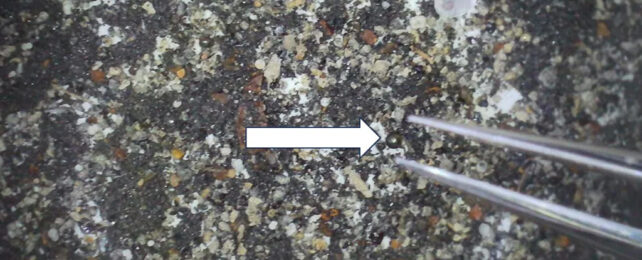Scientists say material found in ocean is not from this solar system
- September 1, 2023
- 0
The tiny beads found off the coast of Papua New Guinea may have come from a rock with a very interesting history that has traveled light-years from its
The tiny beads found off the coast of Papua New Guinea may have come from a rock with a very interesting history that has traveled light-years from its

The tiny beads found off the coast of Papua New Guinea may have come from a rock with a very interesting history that has traveled light-years from its inception around a star other than our Sun. While the findings have yet to undergo peer-review, they are already provoking debate in the scientific community, as the researchers caution against reading the analysis too deeply.
The meteor was tracked by US government satellites before it disintegrated over the Pacific Ocean in 2014. The unusual speed of the meteor bolide, classified as CNEOS 2014-01-08 (or simply IM1), has drawn interest as a potential missile from afar.
For renowned Harvard astronomer Avi Loeb, who launched Project Galileo in 2021 to search for signatures of extraterrestrial technology, this was an opportunity too good to miss. This June he led an expedition to find the remains of IM1.
Using a series of powerful rare-earth magnets, members of the project’s search team sifted through hundreds of tiny spheres 0.05 to 1.3 millimeters in diameter from sediment 2 kilometers (1.2 miles) below the surface, about 85 kilometers north of Manus Island.
Preliminary evaluation of 57 mineral objects by a research team at Harvard University in the USA suggests that at least some of them do not reflect the chemical composition of our solar system that we would expect, strengthening the claim that IM1 had previously traversed interstellar space. crashed into our planet’s atmosphere.

“This is a historic discovery that marks the first time humans have preserved material from a large interstellar object, and I am extremely pleased with the results of this rigorous scientific analysis,” said American entrepreneur Charles Hoskinson, who helped finance the expedition. the remains of a meteorite.
This analysis involved determining the proportions of elements that make up the cluster of globules believed to be shed from the surfaces of meteor fragments as they pass through the atmosphere before falling. Changes in iron isotopes are consistent with traumatic penetration in our atmosphere, supporting the hypothesis that the globules are not of terrestrial origin.
The particles, which are very rich in the metals beryllium (Be), lanthanum (La) and uranium (U), are also unlike the types of materials we can find near our planet. In fact, this particular ratio has never been observed in any meteorite before, pointing to a rare case of a birthplace far from our own solar system.
The analysis adds to the growing field of studying the exchange of rocky materials between stars. Theoretically, objects orbiting a star could be thrown back with enough force to send them into orbit around another star in a fairly regular fashion.
However, cosmically “normal” might still make it rare enough for human observations. We only confirmed our first local interstellar exchange in 2017, when the strange behavior of an asteroid called Oumuamua caught our attention.
Finding the remains of such a visitor on Earth’s surface would be a huge number for astronomers. The reality is that the source of any sample needs to be fairly reliable and goes far beyond the previous chemical sniff test. As with any discovery, the findings are of great interest, and expert opinions range from cautious skepticism to outright skepticism.
Given the Galileo project’s goal of hunting down not only material of extrasolar origin, but also signs of alien technology, the polarization of the conversation and the drawing of a wide range of critical and optimistic views from various corners of academia and beyond is inevitable. The article itself raises the possibility that high uranium content could be a sign that some alien technology is at work. Many in the research community will have more conservative views, at least until more is known about what we’re dealing with here.
Complicating matters further, the expedition came under criticism from Papua New Guinea officials, who claimed that team members may have entered the country illegally with improper visas. As dramatic as it may seem, science has evolved as the practice of weeding out useful ideas from politics, personal beliefs, and outlandish assumptions.
We’ll have to wait a little longer to be sure that this sand really comes from a rock that once enjoyed the warmth of another star. For now, we can only imagine the story it has to tell. Source
Source: Port Altele
As an experienced journalist and author, Mary has been reporting on the latest news and trends for over 5 years. With a passion for uncovering the stories behind the headlines, Mary has earned a reputation as a trusted voice in the world of journalism. Her writing style is insightful, engaging and thought-provoking, as she takes a deep dive into the most pressing issues of our time.